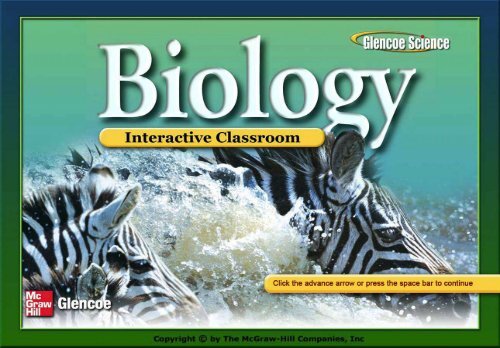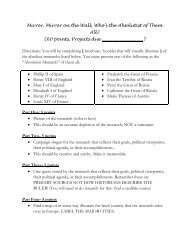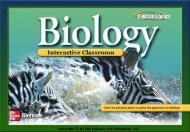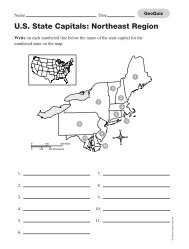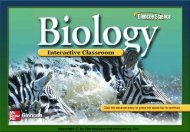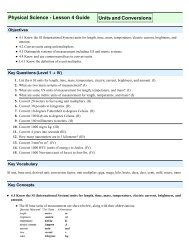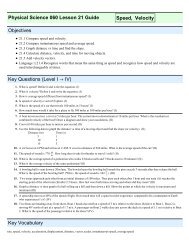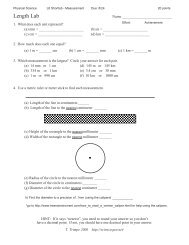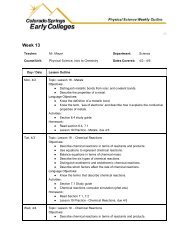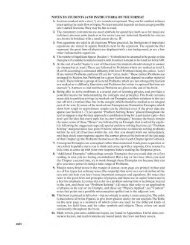Chapter 3 Communities Biomes and Ecosystems.pdf
Chapter 3 Communities Biomes and Ecosystems.pdf
Chapter 3 Communities Biomes and Ecosystems.pdf
- No tags were found...
You also want an ePaper? Increase the reach of your titles
YUMPU automatically turns print PDFs into web optimized ePapers that Google loves.
<strong>Chapter</strong> 3 <strong>Communities</strong>, <strong>Biomes</strong>,<strong>and</strong> <strong>Ecosystems</strong>Section 1:Community EcologySection 2: Terrestrial <strong>Biomes</strong>Section 3: Aquatic <strong>Ecosystems</strong>Click on a lesson name to select.
<strong>Chapter</strong> 3<strong>Communities</strong>, <strong>Biomes</strong>, <strong>and</strong> <strong>Ecosystems</strong>3.1 Community Ecology<strong>Communities</strong>• A biologicalcommunity is agroup ofinteractingpopulations thatoccupy the samearea at the sametime.Oasis
<strong>Chapter</strong> 3<strong>Communities</strong>, <strong>Biomes</strong>, <strong>and</strong> <strong>Ecosystems</strong>3.1 Community EcologyLimiting Factors• Any abiotic factor or biotic factor that restrictsthe numbers, reproduction, or distribution oforganisms is called a limiting factor.• Includes sunlight, climate, temperature, water,nutrients, fire, soil chemistry, <strong>and</strong> space, <strong>and</strong>other living things
<strong>Chapter</strong> 3<strong>Communities</strong>, <strong>Biomes</strong>, <strong>and</strong> <strong>Ecosystems</strong>3.1 Community EcologyRange of Tolerance• An upper limit <strong>and</strong> lower limit that define theconditions in which an organism can survive• The ability of any organism to survive when subjectedto abiotic factors or biotic factors is called tolerance.
<strong>Chapter</strong> 3<strong>Communities</strong>, <strong>Biomes</strong>, <strong>and</strong> <strong>Ecosystems</strong>3.1 Community EcologyEcological Succession• The change in an ecosystem that happenswhen one community replaces another as aresult of changing abiotic <strong>and</strong> biotic factors isecological succession.• There are two types of ecological succession—primary succession <strong>and</strong> secondary succession.
<strong>Chapter</strong> 3<strong>Communities</strong>, <strong>Biomes</strong>, <strong>and</strong> <strong>Ecosystems</strong>3.1 Community Ecology• The establishment of a community in an area ofexposed rock that does not have any topsoil isprimary succession.
<strong>Chapter</strong> 3<strong>Communities</strong>, <strong>Biomes</strong>, <strong>and</strong> <strong>Ecosystems</strong>
<strong>Chapter</strong> 3<strong>Communities</strong>, <strong>Biomes</strong>, <strong>and</strong> <strong>Ecosystems</strong>3.1 Community Ecology• The orderly <strong>and</strong> predictable change that takesplace after a community of organisms hasbeen removed but the soil has remained intactis secondary succession.
<strong>Chapter</strong> 3<strong>Communities</strong>, <strong>Biomes</strong>, <strong>and</strong> <strong>Ecosystems</strong>3.2 Terrestrial <strong>Biomes</strong>Effects of Latitude <strong>and</strong> Climate• Weather is the condition of the atmosphereat a specific place <strong>and</strong> time.• One of the keys to underst<strong>and</strong>ing thesecommunities is to be aware of latitude <strong>and</strong>climatic conditions.
<strong>Chapter</strong> 3<strong>Communities</strong>, <strong>Biomes</strong>, <strong>and</strong> <strong>Ecosystems</strong>3.2 Terrestrial <strong>Biomes</strong>• The distance of anypoint on the surfaceof Earth north orsouth from theequator is latitude.
<strong>Chapter</strong> 3<strong>Communities</strong>, <strong>Biomes</strong>, <strong>and</strong> <strong>Ecosystems</strong>3.2 Terrestrial <strong>Biomes</strong>• The average weatherconditions in an area,including temperature<strong>and</strong> precipitation,describe the area’sclimate.• The graph shows howtemperature <strong>and</strong>precipitation influence the communities.
<strong>Chapter</strong> 3<strong>Communities</strong>, <strong>Biomes</strong>, <strong>and</strong> <strong>Ecosystems</strong>3.2 Terrestrial <strong>Biomes</strong>• <strong>Biomes</strong> are classifiedby their plants,temperature, <strong>and</strong>precipitation.VisualizingGlobal Effectson Climate
<strong>Chapter</strong> 3<strong>Communities</strong>, <strong>Biomes</strong>, <strong>and</strong> <strong>Ecosystems</strong>3.2 Terrestrial <strong>Biomes</strong>Tundra• Average precipitation:15–25 cm per year• Temperature range:-34°C–12°C• Geographic location:South of the polar icecaps in the Northern Hemisphere• Abiotic factors: soggy summers; permafrost; cold<strong>and</strong> dark much of the year
<strong>Chapter</strong> 3<strong>Communities</strong>, <strong>Biomes</strong>, <strong>and</strong> <strong>Ecosystems</strong>3.2 Terrestrial <strong>Biomes</strong>Boreal Forest• Average precipitation:30–84 cm per year• Temperature range:-54°C–21°C• Geographic location:northern part ofNorth America, Europe, <strong>and</strong> Asia• Abiotic factors: summers are short <strong>and</strong> moist;winters are long, cold, <strong>and</strong> dry
<strong>Chapter</strong> 3<strong>Communities</strong>, <strong>Biomes</strong>, <strong>and</strong> <strong>Ecosystems</strong>3.2 Terrestrial <strong>Biomes</strong>Temperate Forest• Average precipitation:75–150 cm per year• Temperature range:-30°C–30°C• Geographic location:south of the borealforests in eastern North America, eastern Asia,Australia, <strong>and</strong> Europe• Abiotic factors: well-defined seasons; summersare hot, winters are cold
<strong>Chapter</strong> 3<strong>Communities</strong>, <strong>Biomes</strong>, <strong>and</strong> <strong>Ecosystems</strong>3.2 Terrestrial <strong>Biomes</strong>Temperate Woodl<strong>and</strong> <strong>and</strong> Shrubl<strong>and</strong>• Average precipitation:38–100 cm per year• Temperature range:10°C–40°C• Geographic location:surrounds the Mediterranean Sea, western coast ofNorth <strong>and</strong> South America, South Africa, <strong>and</strong> Australia• Abiotic factors: summers are very hot <strong>and</strong> dry;winters are cool <strong>and</strong> wet
<strong>Chapter</strong> 3<strong>Communities</strong>, <strong>Biomes</strong>, <strong>and</strong> <strong>Ecosystems</strong>3.2 Terrestrial <strong>Biomes</strong>Temperate Grassl<strong>and</strong>• Average precipitation:50–89 cm per year• Temperature range: -40°C–38°C• Geographic location:North America, South America, Asia, Africa, <strong>and</strong>Australia• Abiotic factors: summers are hot; winters are cold;moderate rainfall; fires possible
<strong>Chapter</strong> 3<strong>Communities</strong>, <strong>Biomes</strong>, <strong>and</strong> <strong>Ecosystems</strong>3.2 Terrestrial <strong>Biomes</strong>Desert• Average precipitation:2–26 cm per year• Temperature range:high: 20°C–49°C;low: -18°C–10°C• Geographic location: every continent except Europe• Abiotic factors: varying temperatures; low rainfall
<strong>Chapter</strong> 3<strong>Communities</strong>, <strong>Biomes</strong>, <strong>and</strong> <strong>Ecosystems</strong>3.2 Terrestrial <strong>Biomes</strong>Tropical Savanna• Average precipitation:50–130 cm per year• Temperature range:20°C–30°C• Geographic location: Africa, South America, <strong>and</strong>Australia• Abiotic factors: summers are hot <strong>and</strong> rainy; wintersare cool <strong>and</strong> dry
<strong>Chapter</strong> 3<strong>Communities</strong>, <strong>Biomes</strong>, <strong>and</strong> <strong>Ecosystems</strong>3.2 Terrestrial <strong>Biomes</strong>Tropical Seasonal Forest• Average precipitation:>200 cm per year• Temperature range:20°C–25°C• Geographic location:Africa, Asia, Australia, <strong>and</strong> South <strong>and</strong> CentralAmerica• Abiotic factors: rainfall is seasonal
<strong>Chapter</strong> 3<strong>Communities</strong>, <strong>Biomes</strong>, <strong>and</strong> <strong>Ecosystems</strong>3.2 Terrestrial <strong>Biomes</strong>Tropical Rain Forest• Average precipitation:200–1000 cm per year• Temperature range:24°C–27°C• Geographic location:Central <strong>and</strong> South America, southern Asia, westernAfrica, <strong>and</strong> northeastern Australia• Abiotic factors: humid all year; hot <strong>and</strong> wet
<strong>Chapter</strong> 3<strong>Communities</strong>, <strong>Biomes</strong>, <strong>and</strong> <strong>Ecosystems</strong>3.2 Terrestrial <strong>Biomes</strong>Mountains• If you go up a mountain, you might notice thatabiotic conditions, such as temperature <strong>and</strong>precipitation, change with increasing elevation.
<strong>Chapter</strong> 3<strong>Communities</strong>, <strong>Biomes</strong>, <strong>and</strong> <strong>Ecosystems</strong>3.2 Terrestrial <strong>Biomes</strong>Penguins in AntarcticaPolar Regions• Border the tundraat high latitudes• Polar regions arecold all year.
<strong>Chapter</strong> 3<strong>Communities</strong>, <strong>Biomes</strong>, <strong>and</strong> <strong>Ecosystems</strong>3.3 Aquatic <strong>Ecosystems</strong>Freshwater <strong>Ecosystems</strong>• Only about 2.5 percent of the water on Earthis freshwater.
<strong>Chapter</strong> 3<strong>Communities</strong>, <strong>Biomes</strong>, <strong>and</strong> <strong>Ecosystems</strong>3.3 Aquatic <strong>Ecosystems</strong>Rivers <strong>and</strong> Streams• The characteristics of rivers <strong>and</strong> streamschange during the journey from the sourceto the mouth.
<strong>Chapter</strong> 3<strong>Communities</strong>, <strong>Biomes</strong>, <strong>and</strong> <strong>Ecosystems</strong>3.3 Aquatic <strong>Ecosystems</strong>• Fast-moving rivers <strong>and</strong> streams preventmuch accumulation of organic materials<strong>and</strong> sediment.• Usually, there are fewer species living inthe rapid waters.• In slow-moving water, insect larvae arethe primary food source for many fish,including American eel, brown bullheadcatfish, <strong>and</strong> trout.
<strong>Chapter</strong> 3<strong>Communities</strong>, <strong>Biomes</strong>, <strong>and</strong> <strong>Ecosystems</strong>3.3 Aquatic <strong>Ecosystems</strong>Lakes <strong>and</strong> Ponds• The temperatureof lakes <strong>and</strong> pondsvaries dependingon the season.
<strong>Chapter</strong> 3<strong>Communities</strong>, <strong>Biomes</strong>, <strong>and</strong> <strong>Ecosystems</strong>3.3 Aquatic <strong>Ecosystems</strong>• Lakes <strong>and</strong> ponds are divided into three zonesbased on the amount of sunlight that penetratesthe water.• The area closest to the shore is the littoral zone.
<strong>Chapter</strong> 3<strong>Communities</strong>, <strong>Biomes</strong>, <strong>and</strong> <strong>Ecosystems</strong>3.3 Aquatic <strong>Ecosystems</strong>• The limnetic zone is the open water area thatis well lit <strong>and</strong> is dominated by plankton.
<strong>Chapter</strong> 3<strong>Communities</strong>, <strong>Biomes</strong>, <strong>and</strong> <strong>Ecosystems</strong>3.3 Aquatic <strong>Ecosystems</strong>• The profundal zone is the deepest areas of alarge lake.• It is much colder <strong>and</strong> lower in oxygen than theother two zones.
<strong>Chapter</strong> 3<strong>Communities</strong>, <strong>Biomes</strong>, <strong>and</strong> <strong>Ecosystems</strong>3.3 Aquatic <strong>Ecosystems</strong>Transitional Aquatic<strong>Ecosystems</strong>• Areas of l<strong>and</strong> such asmarshes, swamps,<strong>and</strong> bogs that aresaturated with water<strong>and</strong> that supportaquatic plants are called wetl<strong>and</strong>s.Bog
<strong>Chapter</strong> 3<strong>Communities</strong>, <strong>Biomes</strong>, <strong>and</strong> <strong>Ecosystems</strong>3.3 Aquatic <strong>Ecosystems</strong>Marine <strong>Ecosystems</strong>• The intertidal zone is anarrow b<strong>and</strong> where theocean meets l<strong>and</strong>.• <strong>Communities</strong> areconstantly changing inthis environment as aresult of disturbance.
<strong>Chapter</strong> 3<strong>Communities</strong>, <strong>Biomes</strong>, <strong>and</strong> <strong>Ecosystems</strong>3.3 Aquatic <strong>Ecosystems</strong>Open Ocean <strong>Ecosystems</strong>• The photic zone isshallow enough thatsunlight is able topenetrate.
<strong>Chapter</strong> 3<strong>Communities</strong>, <strong>Biomes</strong>, <strong>and</strong> <strong>Ecosystems</strong>3.3 Aquatic <strong>Ecosystems</strong>Open Ocean <strong>Ecosystems</strong>• Below the photiczone lies theaphotic zone—anarea wheresunlight is unableto penetrate.
<strong>Chapter</strong> 3<strong>Communities</strong>, <strong>Biomes</strong>, <strong>and</strong> <strong>Ecosystems</strong>3.3 Aquatic <strong>Ecosystems</strong>Open Ocean <strong>Ecosystems</strong>• The benthic zoneis an area alongthe ocean floorthat consists ofs<strong>and</strong>, silt, <strong>and</strong>dead organisms.
<strong>Chapter</strong> 3<strong>Communities</strong>, <strong>Biomes</strong>, <strong>and</strong> <strong>Ecosystems</strong>3.3 Aquatic <strong>Ecosystems</strong>Open Ocean <strong>Ecosystems</strong>• The deepestregion of theocean is calledthe abyssal zone.<strong>Communities</strong><strong>and</strong> <strong>Biomes</strong>
<strong>Chapter</strong> 3<strong>Communities</strong>, <strong>Biomes</strong>, <strong>and</strong> <strong>Ecosystems</strong><strong>Chapter</strong> Resource Menu<strong>Chapter</strong> Diagnostic QuestionsFormative Test Questions<strong>Chapter</strong> AssessmentSt<strong>and</strong>ardized Test Practicebiologygmh.comGlencoe Biology TransparenciesImage BankVocabularyAnimationClick on a hyperlink to view the corresponding lesson.
<strong>Chapter</strong> 3<strong>Communities</strong>, <strong>Biomes</strong>, <strong>and</strong> <strong>Ecosystems</strong><strong>Chapter</strong> DiagnosticQuestionsMosses <strong>and</strong> lichens are the first organisms toappear during which ecological stage of anecosystem?A. primary successionB. secondary successionC. climax communityD. end succession
<strong>Chapter</strong> 3<strong>Communities</strong>, <strong>Biomes</strong>, <strong>and</strong> <strong>Ecosystems</strong><strong>Chapter</strong> DiagnosticQuestionsWhich biome is the most diverse?A. tundraB. tropical savannaC. tropical seasonal forestD. tropical rainforest
<strong>Chapter</strong> 3<strong>Communities</strong>, <strong>Biomes</strong>, <strong>and</strong> <strong>Ecosystems</strong><strong>Chapter</strong> DiagnosticQuestionsWhere is most of Earth’s freshwater supplycontained?A. in groundwaterB. in streamsC. in glaciersD. in wetl<strong>and</strong>s
<strong>Chapter</strong> 3<strong>Communities</strong>, <strong>Biomes</strong>, <strong>and</strong> <strong>Ecosystems</strong>3.1 FormativeQuestionsWhat is a group of interacting populations thatoccupy the same area at the same time?A. a biomeB. a communityC. an ecosystemD. an environment
<strong>Chapter</strong> 3<strong>Communities</strong>, <strong>Biomes</strong>, <strong>and</strong> <strong>Ecosystems</strong>3.1 FormativeQuestionsWhich is true of the zone of physiologicalstress?
<strong>Chapter</strong> 3<strong>Communities</strong>, <strong>Biomes</strong>, <strong>and</strong> <strong>Ecosystems</strong>3.1 FormativeQuestionsA. It is outside the range of tolerance.B. It is the optimum zone for survival.C. Organisms are unable to survive in this zone.D. There are fewer organisms in this zone.
<strong>Chapter</strong> 3<strong>Communities</strong>, <strong>Biomes</strong>, <strong>and</strong> <strong>Ecosystems</strong>3.1 FormativeQuestionsWhat occurs in the process of ecologicalsuccession?A. Environmental factors affect the survival oforganisms.B. One biological community replaces anotherin the ecosystem.C. Organisms adapt to new biotic <strong>and</strong> abioticfactors.D. Pioneer species move in <strong>and</strong> replaceexisting species.
<strong>Chapter</strong> 3<strong>Communities</strong>, <strong>Biomes</strong>, <strong>and</strong> <strong>Ecosystems</strong>3.2 FormativeQuestionsBy what characteristics are biomes primarilyclassified?A. by their average weather conditionsB. by their latitudes <strong>and</strong> climatesC. by the type of animal communities within themD. by the type of plant communities within them
<strong>Chapter</strong> 3<strong>Communities</strong>, <strong>Biomes</strong>, <strong>and</strong> <strong>Ecosystems</strong>3.2 FormativeQuestionsWhich biome contains short grasses, caribou,polar bears, <strong>and</strong> has a layer of permafrostbelow the surface of the soil?A. taigaB. tundraC. arctic grassl<strong>and</strong>D. polar regions
<strong>Chapter</strong> 3<strong>Communities</strong>, <strong>Biomes</strong>, <strong>and</strong> <strong>Ecosystems</strong>3.2 FormativeQuestionsWhich biome is called a steppe in Asia, aprairie in North America, <strong>and</strong> a rangel<strong>and</strong>in Australia?A. boreal shrubl<strong>and</strong>B. moderate meadowl<strong>and</strong>C. temperate grassl<strong>and</strong>D. tropical savanna
<strong>Chapter</strong> 3<strong>Communities</strong>, <strong>Biomes</strong>, <strong>and</strong> <strong>Ecosystems</strong>3.2 FormativeQuestionsWhich is the most diverse of all biomes?A. desertB. tundraC. woodl<strong>and</strong>D. tropical rainforest
<strong>Chapter</strong> 3<strong>Communities</strong>, <strong>Biomes</strong>, <strong>and</strong> <strong>Ecosystems</strong>3.3 FormativeQuestionsWhy do oligotrophic lakes contain fewer plant<strong>and</strong> animal species than eutrophic lakes?A. They have swifter currents.B. They exist near urban areas.C. They exist at higher latitudes.D. They contain less organic matter.
<strong>Chapter</strong> 3<strong>Communities</strong>, <strong>Biomes</strong>, <strong>and</strong> <strong>Ecosystems</strong>3.3 FormativeQuestionsWhich region of the lake has the highestbiodiversity?
<strong>Chapter</strong> 3<strong>Communities</strong>, <strong>Biomes</strong>, <strong>and</strong> <strong>Ecosystems</strong>3.3 FormativeQuestionsA. littoral zoneB. limnetic zoneC. profundal zoneD. benthic zone
<strong>Chapter</strong> 3<strong>Communities</strong>, <strong>Biomes</strong>, <strong>and</strong> <strong>Ecosystems</strong>3.3 FormativeQuestionsWhich is the most diverse ecosystem?A. estuaryB. salt marshC. swampD. wetl<strong>and</strong>
<strong>Chapter</strong> 3<strong>Communities</strong>, <strong>Biomes</strong>, <strong>and</strong> <strong>Ecosystems</strong>3.3 FormativeQuestionsWhat makes an estuary such a unique ecosystem?A. the accumulation of nutrient-rich sediments<strong>and</strong> detritusB. the mixture of waters with different saltconcentrationsC. the variety of species adapted to live in slowcurrentsD. the wide variety of waterfowl that nest<strong>and</strong> feed
<strong>Chapter</strong> 3<strong>Communities</strong>, <strong>Biomes</strong>, <strong>and</strong> <strong>Ecosystems</strong><strong>Chapter</strong> AssessmentQuestionsLook at the figure. Which is not true of theprofundal zone?
<strong>Chapter</strong> 3<strong>Communities</strong>, <strong>Biomes</strong>, <strong>and</strong> <strong>Ecosystems</strong><strong>Chapter</strong> AssessmentQuestionsA. dominated by planktonB. deepest area of the lakeC. very little light penetratesD. lower in oxygen
<strong>Chapter</strong> 3<strong>Communities</strong>, <strong>Biomes</strong>, <strong>and</strong> <strong>Ecosystems</strong><strong>Chapter</strong> AssessmentQuestionsBased on theinformation in thegraph, what can beinferred about carbondioxide in theatmosphere?
<strong>Chapter</strong> 3<strong>Communities</strong>, <strong>Biomes</strong>, <strong>and</strong> <strong>Ecosystems</strong><strong>Chapter</strong> AssessmentQuestionsAnswer: The measured increase of carbondioxide (CO 2 ) in the atmosphereis mainly due to the burning offossil fuels. As carbon dioxidelevels have increased, theaverage global temperature hasincreased.
<strong>Chapter</strong> 3<strong>Communities</strong>, <strong>Biomes</strong>, <strong>and</strong> <strong>Ecosystems</strong><strong>Chapter</strong> AssessmentQuestionsUse the figure below to infer which abiotic factormight limit the survival of steelhead trout.Answer: Temperature
<strong>Chapter</strong> 3<strong>Communities</strong>, <strong>Biomes</strong>, <strong>and</strong> <strong>Ecosystems</strong>St<strong>and</strong>ardized TestPracticeWhat is the most critical limiting factor for apolar bear?A. precipitationB. soil typeC. sunlightD. temperature
<strong>Chapter</strong> 3<strong>Communities</strong>, <strong>Biomes</strong>, <strong>and</strong> <strong>Ecosystems</strong>St<strong>and</strong>ardized TestPracticeTrue or FalseThe mature community in thisdiagram is a true climax community.
<strong>Chapter</strong> 3<strong>Communities</strong>, <strong>Biomes</strong>, <strong>and</strong> <strong>Ecosystems</strong>St<strong>and</strong>ardized TestPracticeFor which biome was this data collected?Average precipitation: 38–100 cm per yearTemperature range: 10°C–40°CAbiotic factors: summers are very hot <strong>and</strong> dry;winters are cool <strong>and</strong> wetA. desertB. boreal forestC. temperate woodl<strong>and</strong>D. tropical seasonal forest
<strong>Chapter</strong> 3<strong>Communities</strong>, <strong>Biomes</strong>, <strong>and</strong> <strong>Ecosystems</strong>St<strong>and</strong>ardized TestPracticeWhat type of community is likely to exist nearthe top of a mountain?
<strong>Chapter</strong> 3<strong>Communities</strong>, <strong>Biomes</strong>, <strong>and</strong> <strong>Ecosystems</strong>St<strong>and</strong>ardized TestPracticeA. tundraB. arctic desertC. coniferous forestD. temperate grassl<strong>and</strong>
<strong>Chapter</strong> 3<strong>Communities</strong>, <strong>Biomes</strong>, <strong>and</strong> <strong>Ecosystems</strong>St<strong>and</strong>ardized TestPracticeWhat type of organisms enables fish to livein the limnetic zone?
<strong>Chapter</strong> 3<strong>Communities</strong>, <strong>Biomes</strong>, <strong>and</strong> <strong>Ecosystems</strong>St<strong>and</strong>ardized TestPracticeA. bottom dwellersB. crustaceansC. insectsD. plankton
<strong>Chapter</strong> 3<strong>Communities</strong>, <strong>Biomes</strong>, <strong>and</strong> <strong>Ecosystems</strong>St<strong>and</strong>ardized TestPracticeWhat is the approximate average temperature <strong>and</strong>annual precipitation in the boreal forest biome?Averagetemperature (°C)Averageprecipitation (cm)A. 0 100B. 10 150C. 20 100D. 25 200
<strong>Chapter</strong> 3<strong>Communities</strong>, <strong>Biomes</strong>, <strong>and</strong> <strong>Ecosystems</strong>Glencoe Biology Transparencies
<strong>Chapter</strong> 3<strong>Communities</strong>, <strong>Biomes</strong>, <strong>and</strong> <strong>Ecosystems</strong>Image Bank
<strong>Chapter</strong> 3<strong>Communities</strong>, <strong>Biomes</strong>, <strong>and</strong> <strong>Ecosystems</strong>Image Bank
<strong>Chapter</strong> 3<strong>Communities</strong>, <strong>Biomes</strong>, <strong>and</strong> <strong>Ecosystems</strong>VocabularySection 1communitylimiting factortoleranceecological successionprimary successionclimax communitysecondary succession
<strong>Chapter</strong> 3<strong>Communities</strong>, <strong>Biomes</strong>, <strong>and</strong> <strong>Ecosystems</strong>VocabularySection 2weatherlatitudeclimatetundraboreal foresttemperate forestwoodl<strong>and</strong>grassl<strong>and</strong>deserttropical savannatropical seasonal foresttropical rain forest
<strong>Chapter</strong> 3<strong>Communities</strong>, <strong>Biomes</strong>, <strong>and</strong> <strong>Ecosystems</strong>VocabularySection 3sedimentlittoral zonelimnetic zoneplanktonprofundal zonewetl<strong>and</strong>sestuaryintertidal zonephotic zoneaphotic zonebenthic zoneabyssal zone
<strong>Chapter</strong> 3<strong>Communities</strong>, <strong>Biomes</strong>, <strong>and</strong> <strong>Ecosystems</strong>Animation• Primary <strong>and</strong> Secondary Solutions:Climax Community• Visualizing Global Effects on Climate


